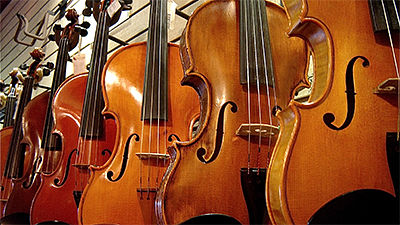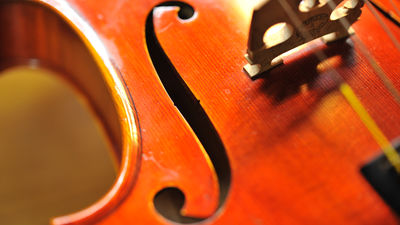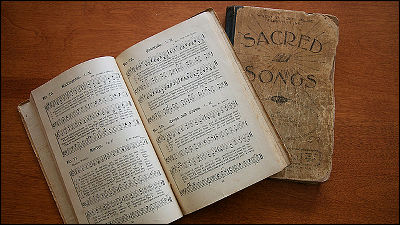Why is there a "F hole" in a violin stringed instrument, what is the origin of that form?

ByAndreanna Moya
Instruments of "violin genus" such as violin, viola, cello and contrabass are traditionally opened in the opening of the letter "F" on the body surface of the instrumentF HoleTo be holding. The shape of this hole was established around the 17th - 18th century, and since then it has been handed down almost without changing the shape, but why did it become that shape and what the actual effect is like Scientifically verified papers have been published.
Why Violins Have F-Holes: The Science & amp; History of a Remarkable Renaissance Design | Open Culture
http://www.openculture.com/2016/01/why-violins-have-f-holes-the-science-history-of-a-remarkable-renaissance-design.html
Unlike instruments such as electric guitars and synthesizers, which can develop large sounds with the help of electricity like electric musical instruments (or electronic musical instruments) developed from the mid 20th century, the body vibrates the vibration of the string rubbed with the bow In the evolution of the stringed instruments such as violin, "It is how to make the sounds greatly" has been regarded as one of the aims of evolution. In the course of such evolution, it was found that the "front plate" (on the front side)Sound HallThere is an opening called a method called. It is said that the shape of this sound hole gradually changed in the evolution of a long instrument, and it reached the F hole like the present age.

ByKubasa
The F hole is arranged symmetrically bilaterally when looking at the top board from the top, so that four strings are stretched between them. The position of this F hole is strictly determined in fact, and when you look closely you can see that the position of "Komaki" that supports the string and the position of the short horizontal bar at the center of the F hole are nearly the same I will.

ByJason Hollinger
The tradition of this F hole has been handed down to some models of guitars that are classified as the same string instrument. However, when the guitar gradually begins to borrow the power of electricity, it is said that the F hole has been strengthening its design elements rather than the original purpose of "to earn a volume".

ByGibson USA
Following the history of the F hole in the violin, its origin is believed to arrive at the violin ancestor "fithele" which was used around the 10th century. Fithele is an instrument that also became the origin of "Fiddle" meaning violin later, circular sound holes were provided on the left and right of the front board as shown at the left of the figure below. After that, the shape of the sound hole changed from a round shape to a semicircle shape, to a letter of "C", further changing the upper and lower ends to a round shape. And it is thought that the front / back length became longer, it changed to the current F shape after going through the thin C shape.

It is thought that establishing the shape of contemporary violin is a family such as Amati family of Italy, Stradivari, Guarneri family who had been making a violin around the 17th and 18th centuries, but F - shaped Some people explain why they settled on the shape using the skin of "Clementine (small oranges)". In the following movie you can see peeling like a F hole as peeling off in a different way than usual.
Renaissance Design - viola, viol, violin, the origin of the F - hole - YouTube
A movie creator who has a mandarin orange in his hand to explain the violin F hole.

I peeled my skin and apparently peeled off radially and appear to be peeling off in a different way.

After peeling off the peeling of two tangerines, if we arrange them on the desk top in order of preference ......

It was shaped like a leather which looked like F hole. This was a movie that explains the idea that F hole is a form that spreads the surface of a sphere that is perfectly shaped efficiently and is arranged in a plane.

"Mandarin skin leather theory" is very interesting, but it seems that there is a strong view that this is not necessarily a correct answer. From the results of research that actually studied 470 instruments actually made from 1560 to 1750, it is clear that the evolution of the F Hall has taken place gradually and steadily.
Acoustic technician of Massachusetts Institute of Technology (MIT) who conducted research,Nicholas · MakrisIn the paper published by Professor's research team and violin producer Roman Barnas et al., The change is compared to "biological evolution theory", the change of sound due to mutation is sifted by natural selection, only the better shape I conclude that it is the last thing left.
The research team has discovered that there is a link between "linear proportionality of conductance" and "sound hole perimeter length". In other words, "As the total length of the sound hole becomes longer, more sound (energy) is released from the body of the violin", but this is further "If the sound hole becomes elongated, it will be lost This means that the surface area of the violin becomes smaller and it is possible to maintain full sound (perfect tone) ". In other words, it states that "F hole is the most efficient shape" was clarified.

ByGuus Krol
There are also episodes that support the evolution theory of F hole. Although the shape of the F hole like present is thought to have been established around the 18th century, at that time its shape was considered to be a provisional one at the time. Although it turned out that the shape of the sound hole was changed in the 19th century after that, the change led by those changes was gradually obsolete as it was not able to receive people's support It seems that the F hole of the 18th century style was eventually conveyed to future generations.

ByPawel Loj
In the following papers presented by Professor McClris and others, efficiency of F-holes is discussed using complicated formulas and pressure distribution simulation, so read mainly about those who are interested in acoustic engineering And it is interesting content.
Proceedings of the Royal Society of London A: Mathematical, Physical and Engineering Sciences

Related Posts:







